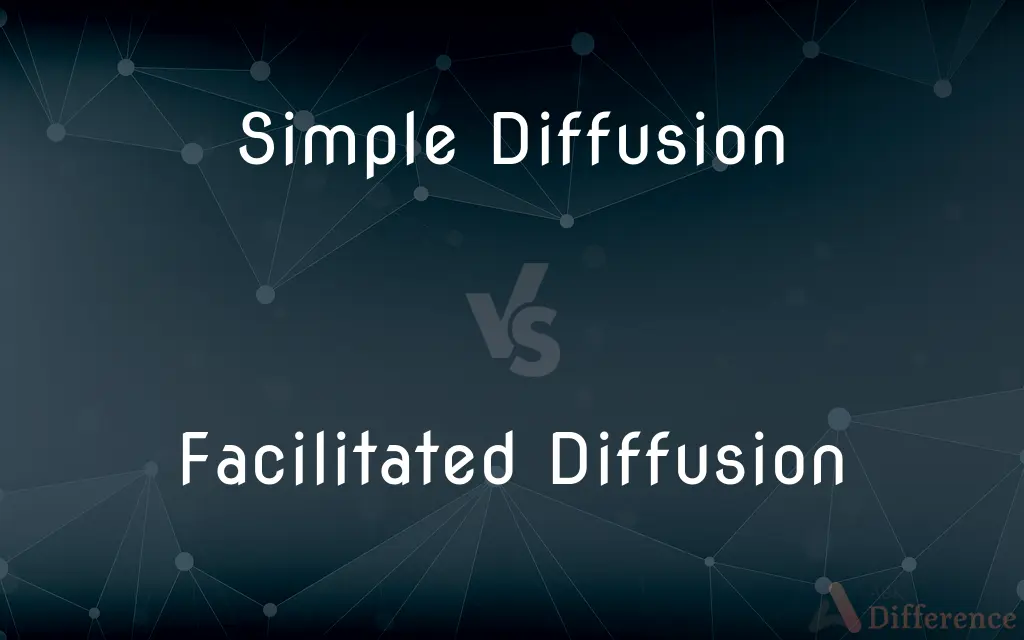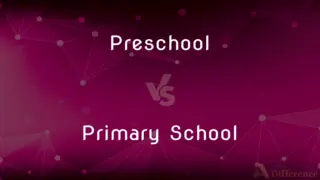Simple Diffusion vs. Facilitated Diffusion — What's the Difference?
By Tayyaba Rehman — Published on December 22, 2023
Simple Diffusion moves molecules via concentration gradients without assistance, while Facilitated Diffusion uses proteins to transport molecules across membranes.

Difference Between Simple Diffusion and Facilitated Diffusion
Table of Contents
ADVERTISEMENT
Key Differences
Simple Diffusion and Facilitated Diffusion are both passive transport mechanisms that cells use to move molecules across their membranes. The former happens without external assistance, while the latter requires help.
In Simple Diffusion, molecules move from an area of high concentration to an area of low concentration, directly through the lipid bilayer of cell membranes. No energy is used in this process, as molecules follow their concentration gradient.
Facilitated Diffusion, on the other hand, utilizes channel or carrier proteins embedded in the cell membrane. These proteins facilitate the movement of specific molecules that can't pass through the lipid bilayer unassisted, like glucose or ions.
Simple Diffusion generally involves nonpolar or small polar molecules, such as oxygen and carbon dioxide. Facilitated Diffusion typically transports larger or charged molecules, which can't easily penetrate the hydrophobic core of the membrane.
While both Simple Diffusion and Facilitated Diffusion are passive processes (no energy required), the latter's need for protein assistance differentiates it from the unassisted movement of the former.
ADVERTISEMENT
Comparison Chart
Mechanism
Direct through lipid bilayer
Via channel or carrier proteins
Molecules Involved
Nonpolar or small polar molecules
Larger or charged molecules
Energy Requirement
None (passive)
None (passive)
Examples
Oxygen, Carbon dioxide
Glucose, ions
Dependence on Proteins
Not required
Required
Compare with Definitions
Simple Diffusion
Passive transport mechanism.
Simple Diffusion doesn't require energy.
Facilitated Diffusion
For molecules unable to diffuse directly.
Charged ions use Facilitated Diffusion.
Simple Diffusion
Moves along concentration gradient.
Perfume scent spreads in a room via Simple Diffusion.
Facilitated Diffusion
Transport via channel or carrier proteins.
Glucose enters cells via Facilitated Diffusion.
Simple Diffusion
Direct movement through lipid bilayer.
Oxygen enters cells through Simple Diffusion.
Facilitated Diffusion
Moves specific molecules across membranes.
Calcium ions utilize Facilitated Diffusion.
Simple Diffusion
Usually involves nonpolar molecules.
Carbon dioxide exits cells through Simple Diffusion.
Facilitated Diffusion
Relies on protein specificity.
Each protein in Facilitated Diffusion has a specific molecule to transport.
Simple Diffusion
Unassisted molecular movement.
Alcohol enters the bloodstream through Simple Diffusion.
Facilitated Diffusion
Passive process requiring protein assistance.
Facilitated Diffusion moves ions without energy.
Common Curiosities
Why is Facilitated Diffusion necessary?
Some molecules can't pass through the lipid bilayer without assistance.
Which molecules typically use Simple Diffusion?
Nonpolar or small polar molecules, like oxygen and carbon dioxide.
Do both Simple Diffusion and Facilitated Diffusion require energy?
No, both are passive transport mechanisms.
Can ions use Simple Diffusion?
Typically, no. Ions usually rely on Facilitated Diffusion.
Is Facilitated Diffusion selective?
Yes, it's specific to certain molecules using channel or carrier proteins.
How does Simple Diffusion differ from Facilitated Diffusion?
Simple Diffusion is direct through the membrane, while Facilitated Diffusion uses proteins.
Does Simple Diffusion use proteins?
No, it's a direct movement through the lipid bilayer.
Why don't all molecules use Simple Diffusion?
The lipid bilayer prevents larger or charged molecules from passing through directly.
Which transport method is faster?
It depends on the molecule and concentration gradient, but Simple Diffusion can be faster for small molecules.
What's a common example of Facilitated Diffusion?
Glucose entering cells.
What drives Facilitated Diffusion?
The concentration gradient of the molecule being transported.
Is water transported by Simple Diffusion?
Water mainly uses a special type of Facilitated Diffusion called osmosis.
Do all cells utilize Facilitated Diffusion?
Most cells have some molecules that require it for transport.
Can Facilitated Diffusion go against a concentration gradient?
No, like Simple Diffusion, it's a passive process driven by the gradient.
Can Facilitated Diffusion become saturated?
Yes, if all available proteins are occupied, the rate won't increase despite a higher concentration gradient.
Share Your Discovery

Previous Comparison
Preschool vs. Primary School
Next Comparison
Few vs. A FewAuthor Spotlight
Written by
Tayyaba RehmanTayyaba Rehman is a distinguished writer, currently serving as a primary contributor to askdifference.com. As a researcher in semantics and etymology, Tayyaba's passion for the complexity of languages and their distinctions has found a perfect home on the platform. Tayyaba delves into the intricacies of language, distinguishing between commonly confused words and phrases, thereby providing clarity for readers worldwide.
















































